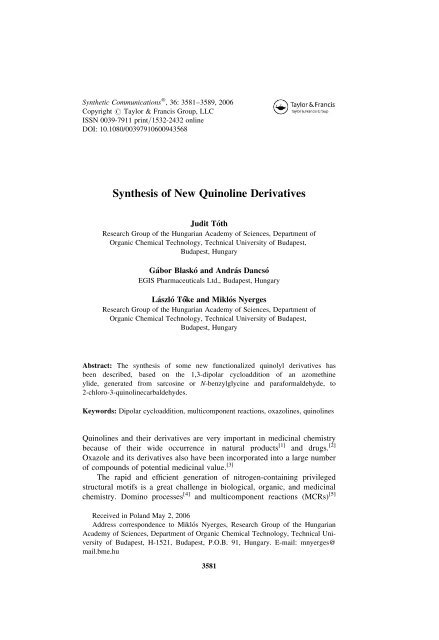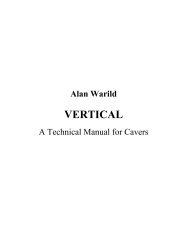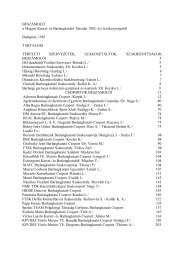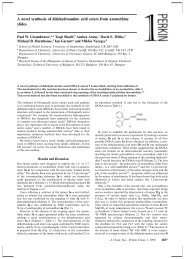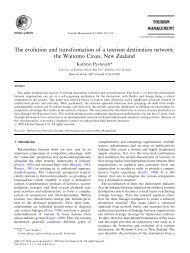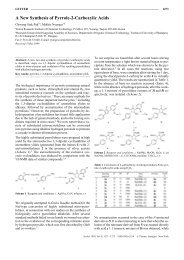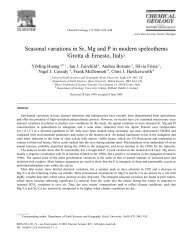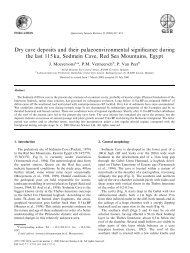Synthesis of New Quinoline Derivatives
Synthesis of New Quinoline Derivatives
Synthesis of New Quinoline Derivatives
Create successful ePaper yourself
Turn your PDF publications into a flip-book with our unique Google optimized e-Paper software.
Synthetic Communications w , 36: 3581–3589, 2006<br />
Copyright # Taylor & Francis Group, LLC<br />
ISSN 0039-7911 print/1532-2432 online<br />
DOI: 10.1080/00397910600943568<br />
<strong>Synthesis</strong> <strong>of</strong> <strong>New</strong> <strong>Quinoline</strong> <strong>Derivatives</strong><br />
Judit Tóth<br />
Research Group <strong>of</strong> the Hungarian Academy <strong>of</strong> Sciences, Department <strong>of</strong><br />
Organic Chemical Technology, Technical University <strong>of</strong> Budapest,<br />
Budapest, Hungary<br />
Gábor Blaskó and András Dancsó<br />
EGIS Pharmaceuticals Ltd., Budapest, Hungary<br />
László Tó´ke and Miklós Nyerges<br />
Research Group <strong>of</strong> the Hungarian Academy <strong>of</strong> Sciences, Department <strong>of</strong><br />
Organic Chemical Technology, Technical University <strong>of</strong> Budapest,<br />
Budapest, Hungary<br />
Abstract: The synthesis <strong>of</strong> some new functionalized quinolyl derivatives has<br />
been described, based on the 1,3-dipolar cycloaddition <strong>of</strong> an azomethine<br />
ylide, generated from sarcosine or N-benzylglycine and paraformaldehyde, to<br />
2-chloro-3-quinolinecarbaldehydes.<br />
Keywords: Dipolar cycloaddition, multicomponent reactions, oxazolines, quinolines<br />
<strong>Quinoline</strong>s and their derivatives are very important in medicinal chemistry<br />
because <strong>of</strong> their wide occurrence in natural products [1] and drugs. [2]<br />
Oxazole and its derivatives also have been incorporated into a large number<br />
<strong>of</strong> compounds <strong>of</strong> potential medicinal value. [3]<br />
The rapid and efficient generation <strong>of</strong> nitrogen-containing privileged<br />
structural motifs is a great challenge in biological, organic, and medicinal<br />
chemistry. Domino processes [4] and multicomponent reactions (MCRs) [5]<br />
Received in Poland May 2, 2006<br />
Address correspondence to Miklós Nyerges, Research Group <strong>of</strong> the Hungarian<br />
Academy <strong>of</strong> Sciences, Department <strong>of</strong> Organic Chemical Technology, Technical University<br />
<strong>of</strong> Budapest, H-1521, Budapest, P.O.B. 91, Hungary. E-mail: mnyerges@<br />
mail.bme.hu<br />
3581
3582<br />
J. Tóth et al.<br />
<strong>of</strong>fer excellent avenues to face these challenges. As a part <strong>of</strong> our research<br />
program aimed at synthesizing nitrogen-containing druglike heterocyles by<br />
the combined use <strong>of</strong> domino and multicomponent reactions, we became<br />
interested in the oxazolidine-coupled quinoline molecules 3.<br />
RESULTS AND DISCUSSION<br />
The starting quinolines (2a–d) for the MCR were prepared by the method<br />
described by O. Meth-Cohn from the corresponding acetanilides by the<br />
treatment with the Vilsmeier reagent in a very effective domino reaction. [6]<br />
Recently we have described the three-component reaction <strong>of</strong> aromatic<br />
aldehydes, sarcosine, and paraformaldehyde, with a view to preparing<br />
3-methyl-5-aryl-oxazolidines, which were valuable intermediates for<br />
further elaboration to 2-dimethylamino-1-phenylethanols. [7] This process<br />
utilizes a 1,3-dipolar cycloaddition reaction, which generally affords a<br />
simple and convenient method for the regio- and stereoselective construction<br />
<strong>of</strong> a variety <strong>of</strong> complex pyrrolidine derivatives. However, the azomethine<br />
ylides can react with C 5O double bonds in 1,3-dipolar cycloadditions, and<br />
several oxazolidine-type cycloadducts have been described, but in these<br />
cases either (a) the aldehyde component <strong>of</strong> the azomethine ylide, formed in<br />
situ, was the same as the dipolarophile, [8] or (b) a stable precursor <strong>of</strong> the<br />
azomethine ylide was prepared in advance and this was followed by the<br />
cycloaddition step. [8a,9]<br />
Based on these results, we synthesized with our MCR a variety <strong>of</strong> 5-(3-<br />
quinolyl)-oxazilidine 3 by simple mixing <strong>of</strong> sarcosine or N-benzylglycine,<br />
paraformaldehyde, and a 2-chloro-3-formyl-quinoline (as the dipolarophile)<br />
in toluene and refluxing under Dean–Stark conditions (Scheme 1). In all<br />
cases only the formaldehyde served as a component for the nonstabilized azomethine<br />
ylide generation, and the cycloadduct 3a–h was isolated in good<br />
yield as the sole product (Table 1).<br />
The heterocyclic ring structure <strong>of</strong> products 3a–e was confirmed by IR, 1 H<br />
NMR, and 13 C NMR spectral studies. The 1 H NMR and H-HCOSY spectra <strong>of</strong><br />
3c reveal two sharp singlets at d 2.53 and 3.92 due to the OCH 3 <strong>of</strong> the<br />
Scheme 1.
<strong>Synthesis</strong> <strong>of</strong> <strong>New</strong> <strong>Quinoline</strong> <strong>Derivatives</strong> 3583<br />
Table 1. 1,3-Dipolar addition reaction <strong>of</strong> 2-chloro-3-formyl-quinolines (2a–e) and<br />
azomethine ylide generated from paraformaldehyde and sarcosine<br />
Entry R 1 R 2 R 3 Starting material Product Yield (%)<br />
1 H H H 2a 3a 92<br />
2 H H Ph 2a 3b 84<br />
3 H MeO H 2b 3c 87<br />
4 H MeO Ph 2b 3d 65<br />
5 Cl Me H 2c 3e 95<br />
6 Cl Me Ph 2c 3f 80<br />
7 Me H H 2d 3g 91<br />
8 Me H Ph 2d 3h 78<br />
quinoline and N-methyl oxazolidine protons. Both <strong>of</strong> the N–CH 2 proton <strong>of</strong><br />
H-4 appeared as a doublet <strong>of</strong> a doublet at d 3.62 and 2.85 (J ¼ 6.7 and<br />
11.3 Hz). The H-5 proton exhibited as triplet at d 5.35 with J ¼ 6.5 Hz.<br />
Two doublets appeared in the region d 4.66–4.53 (J ¼ 5.1 Hz) for H-2<br />
protons.<br />
The aromatic protons <strong>of</strong> the quinoline ring appeared as in the region <strong>of</strong> d<br />
8.26–7.29 with the expected pattern. The 13 C NMR spectra <strong>of</strong> 3c exhibited<br />
peaks at d 89.3, 73.6, and 61.4 ppm for the oxazolidine ring carbons. The<br />
peaks at d 55.5 ppm and at d 41.7 ppm are due to the oxazolidine N-methyl<br />
and methoxy carbons <strong>of</strong> the quinoline ring respectively.<br />
In conclusion, we have developed a new, two-step route by the combined<br />
use <strong>of</strong> domino and multicomponent reactions from simple starting materials<br />
for the synthesis <strong>of</strong> a 3-quinolyl-1,3-oxazolone ring system via the 1,3-<br />
dipolar cycloaddition reaction <strong>of</strong> nonstabilized azomethine ylides to<br />
aldehydes. This oxazolidines could be valuable building blocks <strong>of</strong> other<br />
compunds <strong>of</strong> general interest. [10]<br />
EXPERIMENTAL<br />
General<br />
Column chromatography was performed using Merck Kieselgel 60 70–230<br />
mesh and thin-layer chromatography (TLC) on aluminium sheets coated<br />
with Kieselgel 60 F 254 . Plates were stained with anisaldehyde solution<br />
(100 ml glacial acetic acid, 2 ml <strong>of</strong> concn. sulphuric acid, and 1 ml <strong>of</strong> anisaldehyde)<br />
and heated at ca. 1508C. Phosphoryl chloride (Aldrich) and N,Ndimethylformamide,<br />
anhydrous (Aldrich) were used as received. All<br />
solvents were purified according to standard procedures. IR spectra were<br />
obtained on a Bruker Vector 22 FT-IR instrument. NMR spectra were
3584<br />
J. Tóth et al.<br />
obtained on Varian Inova 500 and Bruker DRX-500. Chemical shifts are given<br />
relative to d TMS .<br />
General Procedure for the <strong>Synthesis</strong> <strong>of</strong> 2-Chloro-3-<br />
quinolinecarbaldehydes (2a–d)<br />
These compounds were prepared by the method <strong>of</strong> Meth-Cohn et al. [6]<br />
N,N-Dimethylformamide (9.1 g, 9.6 ml, 0.125 mol) was cooled to 08C, and<br />
phosphoryl chloride (53.7 g, 32.2 ml, 0.35 mol) was added dropwise with<br />
stirring. To this solution was added the corresponding acetanilide<br />
(0.05 mol), and the temperature <strong>of</strong> the reaction mixture was raised to 808C<br />
for 18 h. The cooled reaction mixture was poured into ice water (300 ml)<br />
and stirred for 1 h at 0–108C. The precipitated 2-chloro-3-quinolinecarbaldehyde<br />
was failtered <strong>of</strong>f, washed with water (100 ml), dried, and recrystallized<br />
from ethyl acetate to give the title product.<br />
Data<br />
2-Chloro-3-quinolinecarbaldehyde (2a): pale yellow powder (5.92 g, 62%),<br />
mp 146–1478C (lit. [6b] 148–1498C); 1 H NMR (500 MHz, CDCl 3 ): 10.51<br />
(s, 1H, CHO), 8.81 (s, 1H, H-4), 8.09 (d, 1H, J ¼ 8.2 Hz, H-5), 8.03 (d, 1H,<br />
J ¼8.2 Hz, H-8), 7.92 (t, 1H, J ¼ 8.2 Hz, H-6), 7.69 (t, 1H, J ¼ 8.2 Hz,<br />
H-7); HRMS (E.I) [M] þ calcd. for C 10 H 6 C1NO ¼ 191.01379; found<br />
191.0147.<br />
2-Chloro-6-methoxy-3-quinolinecarbaldehyde (2b): pale yellow powder<br />
(5.41 g, 49%), mp 143–1448C (lit. [6b] 145.5–146.58C);<br />
1 H NMR<br />
(500 MHz, CDCl 3 ): 10.50 (s, 1H, CHO), 8.57 (s, 1H, H-4), 7.91 (d, 1H,<br />
J ¼ 9.0 Hz, H-8); 7.46 (dd, 1H, J ¼ 9.0 Hz and 2.8 Hz, H-7), 7.17 (d, 1H,<br />
J ¼ 2.8 Hz, H-5), 3.94 (s, 3H, OCH 3 ); HRMS (E.I) [M] þ calcd. for<br />
C 11 H 8 C1NO 2 ¼ 221.02436; found 221.0261.<br />
2,6-Dichloro-8-methyl-3-quinolinecarbaldehyde (2c): pale yellow powder<br />
(4.68 g, 39%), mp 146–1488C; 1 H NMR (500 MHz, CDCl 3 ): 10.55 (s, 1H,<br />
CHO), 8.61 (s, 1H, H-4), 7.78 (s, 1H, H-5), 7.67 (s, 1H, H-7), 2.77 (s, 3H,<br />
Me); 13 C NMR (125 MHz, CDCl 3 ): 189.1 (q), 149.2 (q), 147.2 (q), 139.3<br />
(CH), 139.2 (q), 134.1 (CH), 133.5 (q), 127.2 (q), 126.8 (q), 125.8 (CH),<br />
17.7 (CH 3 ); IR (KBr, cm 21 ): 3050, 1693, 1628, 1582, 1379, 1038. HRMS<br />
(E.I) [M] þ calcd. for C 11 H 7 C1 2 NO ¼ 238.99047; found 238.9911.<br />
2-Chloro-8-methyl-3-quinolinecarbaldehyde (2d): pale yellow powder<br />
(7.40 g, 72%), mp 1388C (lit. [6b] 137–1388C);<br />
1 H NMR (500 MHz,<br />
CDCl 3 ): 10.52 (s, 1H, CHO), 8.64 (s, 1H, H-4), 7.76 (d, 1H, J ¼ 8.2 Hz,
<strong>Synthesis</strong> <strong>of</strong> <strong>New</strong> <strong>Quinoline</strong> <strong>Derivatives</strong> 3585<br />
H-5), 7.68 (d, 1H, J ¼ 8.2 Hz, H-7), 7.50 (t, 1H, J ¼ 8.2 Hz, H-6), 2.75 (s, 3H,<br />
CH 3 ); HRMS (E.I) [M] þ calcd. for C 11 H 8 C1NO ¼ 205.02944; found<br />
205.0301.<br />
General Procedure for the Cycloaddition Reaction <strong>of</strong> Azomethine<br />
Ylide Generated from Paraformaldehyde and Sarcosine<br />
or N-Benzyl Glycine with 2-Chloro-3-formyl-quinolines (2a–d)<br />
The corresponding 2-chloro-3-formyl-quinoline (1 mmol), sarcosine or<br />
N-benzyl-glycine (2 mmol), and paraformaldehyde (5 mmol), were<br />
suspended in toluene (50 ml), and the reaction mixture was then heated for<br />
10 h under Dean–Stark conditions. After the reaction was complete, it was<br />
filtered through a pad <strong>of</strong> Celite, the solvent was removed in vacuo, and the<br />
residue was purified by flash chromatography (acetone/hexane 1:3).<br />
Data<br />
5-(2-Chloro-3-quinolyl)-3-methyl-1,3-oxazolone (3a): pale yellow oil.<br />
NMR (500 MHz, CDCl 3 ): 8.40 (s, 1H, qui-H-4), 7.97 (d, 1H, J ¼ 8.2 Hz,<br />
qui-H-5), 7.68 (d, 1H, J ¼ 8.2 Hz, qui-H-8), 7.55 (t, 1H, J ¼ 8.2 Hz, qui-<br />
H-6), 7.50 (t, 1H, J ¼ 8.2 Hz, qui-H-7), 5.35 (t, 1H, J ¼ 6.9 Hz, H-5), 4.65<br />
(d, 1H, J ¼ 5.0 Hz, H-2), 4.52 (d, 1H, J ¼ 5.0 Hz, H-2), 3.61 (dd, 1H,<br />
J ¼ 6.9 and 11.1 Hz, H-4), 2.85 (dd, 1H, J ¼ 6.9 and 11.1 Hz, H-4), 2.51<br />
(s, 3H, NCH 3 ); 13 C NMR (125 MHz, CDCl 3 ): 148.0 (q), 146.6 (q), 146.65<br />
(q), 134.4 (CH), 129.9 (CH), 127.9 (CH), 127.4 (CH), 127.1 (q), 126.9 (CH),<br />
89.2 (CH 2 ), 73.4 (CH), 61.2 (CH 2 ), 41.4 (CH 3 ); IR (neat, cm 21 ): 3061, 2951,<br />
2870, 2800, 1676, 1619, 1592, 1565, 1492, 1455, 1398, 1326, 1158, 1055,<br />
1029; HRMS (E.I) [M] þ calcd. for C 13 H 13 C1 N 2 O ¼ 248.07164; found<br />
248.0739.<br />
5-(2-Chloro-3-quinolyl)-3-benzyl-1,3-oxazolone (3b): pale yellow oil. 1 H<br />
NMR (500 MHz, CDCl 3 ): 8.36 (s, 1H, qui-H-4), 7.99 (d, 1H, J ¼ 7.8 Hz,<br />
qui-H-5), 7.81 (d, 1H, J ¼ 7.8 Hz, qui-H-8), 7.67 (t, 1H, J ¼ 7.8 Hz, qui-H-<br />
6), 7.52 (t, 1H, J ¼ 7.8 Hz, qui-H-7), 7.34–7.24 (m, 5H, Ph), 5.35 (t, 1H,<br />
J ¼ 7.0 Hz, H-5), 4.67 (d, 1H, J ¼ 5.5 Hz, H-2), 4.63 (d, 1H, J ¼ 5.5 Hz,<br />
H-2), 3.81 (s, 2H, NCH 2 ), 3.74 (dd, 1H, J ¼ 7.0 and 11.7 Hz, H-4), 2.86<br />
(dd, 1H, J ¼ 7.0 and 11.7 Hz, H-4); 13 C NMR (125 MHz, CDCl 3 ): 148.1<br />
(q), 146.7 (q), 138.2 (q), 134.4 (q), 134.3 (q), 129.9 (CH), 128.5 (2 CH),<br />
128.3 (2 CH), 128.0 (CH), 127.5 (CH), 127.3 (CH), 127.2 (CH),<br />
127.0 (CH), 87.2 (CH 2 ), 73.4 (CH), 59.2 (CH 2 ), 58.3 (CH 2 ). IR (neat,<br />
cm 21 ): 3062, 2927, 2876, 1676, 1592, 1565, 1493, 1454, 1398, 1326, 1076,<br />
927; HRMS (E.I) [M] þ calcd. for C 19 H 17 C1 N 2 O ¼ 324.10294; found<br />
324.1001.<br />
1 H
3586<br />
J. Tóth et al.<br />
5-(6-Methoxy-2-chloro-3-quinolyl)-3-methyl-1,3-oxazolone (3c): pale<br />
yellow oil. 1 H NMR (500 MHz, CDCl 3 ): 8.26 (s, 1H, qui-H-4), 7.89 (d, 1H,<br />
J ¼ 9.2 Hz, qui-H-8), 7.35 (dd, 1H, J ¼ 2.8 and 9.2 Hz, qui-H-7), 7.09<br />
(d, 1H, J ¼ 2.8 Hz, qui-H-5), 5.35 (t, 1H, J ¼ 6.5 Hz, H-5), 4.66 (d, 1H,<br />
J ¼ 5.1 Hz, H-2), 4.53 (d, 1H, J ¼ 5.1 Hz, H-2), 3.92 (s, 3H, OCH 3 ), 3.62<br />
(dd, 1H, J ¼ 6.7 and 11.3 Hz, H-4), 2.85 (dd, 1H, J ¼ 6.7 and 11.3 Hz,<br />
H-4), 2.53 (s, 3H, NCH 3 ); 13 C NMR (125 MHz, CDCl 3 ): 158.2 (CH), 145.5<br />
(q), 142.8 (q), 134.7 (CH), 133.3 (q), 129.5 (CH), 128.4 (q), 122.7 (CH),<br />
105.2 (CH), 89.3 (CH 2 ), 73.6 (CH), 61.4 (CH 2 ), 55.5 (CH 3 ), 41.7 (CH 3 );<br />
IR (neat, cm 21 ): 2955, 2870, 2801, 1671, 1623, 1592, 1498, 1455,<br />
1329, 1228, 1165, 1123, 1056, 1032, 959; HRMS (E.I) [M] þ calcd. for<br />
C 14 H 15 C1 N 2 O 2 ¼ 278.08220; found 278.0852.<br />
5-(6-Methoxy-2-chloro-3-quinolyl)-3-benzyl-1,3-oxazolone (3d): pale yellow<br />
oil. 1 H NMR (500 MHz, CDCl 3 ): 8.25 (s, 1H, qui-H-4), 7.86 (d, 1H, J ¼ 9.2 Hz,<br />
qui-H-8), 7.33–7.25 (m, 6H, Ph and qui-H-7), 7.06 (d, 1H, J ¼ 2.8 Hz, qui-H-<br />
5), 5.33 (t, 1H, J ¼ 6.8 Hz, H-5), 4.66 (d, 1H, J ¼ 5.5 Hz, H-2), 3.87 (s, 3H,<br />
OCH 3 ), 3.81 (s, 2H, NCH 2 ), 3.72 (dd, 1H, J ¼ 6.8 and 11.8 Hz, H-4), 3.57<br />
(dd, 1H, J ¼ 6.8 and 11.8 Hz, H-4); 13 C NMR (125 MHz, CDCl 3 ): 158.0 (q),<br />
145.4 (q), 142.6 (q), 138.2 (q), 134.5 (q), 133.1 (CH), 129.3 (CH), 128.5<br />
(2 CH), 128.3 (2 CH), 128.2 (q), 127.2 (CH), 122.5 (CH), 105.0 (CH),<br />
87.1 (CH 2 ), 73.3 (CH), 59.2 (CH 2 ), 58.2 (CH 2 ), 55.3 (CH 3 ). IR (neat, cm 21 ):<br />
3062, 2935, 2878, 1674, 1594, 1498, 1454, 1329, 1061, 998; HRMS (E.I)<br />
[M] þ calcd. for C 20 H 19 C1 N 2 O 2 ¼ 354.11350; found 354.1147.<br />
5-(2,8-Dichloro-6-methyl-3-quinolyl)-3-methyl-1,3-oxazolone (3e): pale<br />
yellow oil. 1 H NMR (500 MHz, CDCl 3 ): 8.23 (s, 1H, qui-H-4), 7.65 (d, 1H,<br />
J ¼ 2.1 Hz, qui-H-5), 7.49 (d, 1H, J ¼ 2.1 Hz, qui-H-7), 5.35 (t, 1H,<br />
J ¼ 6.5 Hz, H-5), 4.65 (d, 1H, J ¼ 5.1 Hz, H-2), 4.53 (d, 1H, J ¼ 5.1 Hz,<br />
H-2), 3.56 (dd, 1H, J ¼ 6.5 and 11.5 Hz, H-4), 2.84 (dd, 1H, J ¼ 6.5 and<br />
11.5 Hz, H-4), 2.73 (s, 3H, CH 3 ), 2.52 (s, 3H, CH 3 ); 13 C NMR (125 MHz,<br />
CDCl 3 ): 147.4 (q), 144.6 (q), 138.6 (q), 135.5 (q), 133.8 (CH), 132.4 (q),<br />
130.8 (CH), 128.0 (q), 124.0 (CH), 89.4 (CH 2 ), 73.5 (CH), 61.3 (CH 2 ), 41.6<br />
(CH 3 ), 17.6 (CH 3 ); IR (KBR, cm 21 ): 3694, 2963, 2794, 1654, 1522, 1322,<br />
1263, 1099, 1022; HRMS (E.I) [M] þ calcd. for C 14 H 14 C1 2 N 2 O ¼ 296.04831;<br />
found 296.0499.<br />
5-(2,8-Dichloro-6-methyl-3-quinolyl)-3-benzyl-1,3-oxazolone (3f): pale<br />
yellow oil. 1 H NMR (500 MHz, CDCl 3 ): 8.24 (s, 1H, qui-H-4), 7.65 (s, 1H,<br />
qui-H-5), 7.49 (s, 1H, qui-H-7), 7.36–7.25 (m, 5H, Ph), 5.35 (t, 1H,<br />
J ¼ 7.0 Hz, H-5), 4.67 (d, 1H, J ¼ 5.6 Hz, H-2), 4.63 (d, 1H, J ¼ 5.6 Hz,<br />
H-2), 3.83 (s, 2H, NCH 2 ), 3.76 (dd, 1H, J ¼ 7.0 and 11.8 Hz, H-4), 3.73<br />
(dd, 1H, J ¼ 7.0 and 11.8 Hz, H-4), 2.72 (s, 3H, CH 3 );<br />
13 C NMR<br />
(125 MHz, CDCl 3 ): 147.4 (q), 144.6 (q), 138.6 (q), 138.3 (q), 135.4 (q),<br />
133.8 (CH), 132.4 (q), 130.8 (CH), 128.7 (2 CH), 128.5 (2 CH), 127.9
<strong>Synthesis</strong> <strong>of</strong> <strong>New</strong> <strong>Quinoline</strong> <strong>Derivatives</strong> 3587<br />
(q), 127.4 (CH), 124.1 (CH), 87.4 (CH 2 ), 73.4 (CH), 59.3 (CH 2 ), 58.4 (CH 2 ),<br />
17.6 (CH 3 ); IR (neat, cm 21 ): 3063, 2925, 2876, 1701, 1592, 1479, 1454, 1327,<br />
1053, 997; HRMS (E.I) [M] þ calcd. for C 20 H 18 C1 2 N 2 O ¼ 372.07961; found<br />
372.0811.<br />
5-(8-Methyl-2-chloro-3-quinolyl)-3-methyl-1,3-oxazolone (3g): pale yellow<br />
oil.<br />
1 H NMR (500 MHz, CDCl 3 ): 8.31 (s, 1H, qui-H-4), 7.65 (d, 1H,<br />
J ¼ 8.1 Hz, qui-H-5), 7.52 (d, 1H, J ¼ 8.1 Hz, qui-H-7), 7.42 (t, 1H, J ¼<br />
8.1 Hz, qui-H-6), 5.36 (t, 1H, J ¼ 6.7 Hz, H-5), 4.65 (d, 1H, J ¼ 5.0 Hz,<br />
H-2), 4.53 (d, 1H, J ¼ 5.1 Hz, H-2), 3.63 (dd, 1H, J ¼ 6.7 and 11.5 Hz,<br />
H-4), 2.85 (dd, 1H, J ¼ 6.7 and 11.5 Hz, H-4), 2.75 (s, 3H, CH 3 ), 2.53<br />
(s, 3H, NCH 3 ); 13 C NMR (125 MHz, CDCl 3 ): 147.1 (q), 146.1 (q), 136.2<br />
(CH), 134.6 (q), 134.1 (q), 130.0 (CH), 127.3 (CH), 126.7 (q), 125.5 (CH),<br />
89.3 (CH 2 ), 73.5 (CH), 61.4 (CH 2 ), 41.6 (CH 3 ), 17.7 (CH 3 ); IR (neat,<br />
cm 21 ): 3010, 2952, 2860, 2806, 1653, 1599, 1576, 1485,1463, 1395, 1377,<br />
1363, 1323, 1206, 1170, 1122, 1088, 1060, 1044, 1009; HRMS (E.I)<br />
[M] þ calcd. for C 14 H 15 C1 N 2 O ¼ 262.08729; found 262.0879.<br />
5-(8-Methyl-2-chloro-3-quinolyl)-3-benzyl-1,3-oxazolone (3h): pale yellow<br />
oil.<br />
1 H NMR (500 MHz, CDCl 3 ): 8.32 (s, 1H, qui-H-4), 7.66 (d, 1H,<br />
J ¼ 7.2 Hz, qui-H-5), 7.51 (d, 1H, J ¼ 7.2 Hz, qui-H-7), 7.42 (t, 1H,<br />
J ¼ 7.2 Hz, qui-H-6), 7.34–7.22 (m, 5H, Ph), 5.36 (t, 1H, J ¼ 6.7 Hz, H-5),<br />
4.67 (d, 1H, J ¼ 5.5 Hz, H-2), 4.63 (d, 1H, J ¼ 5.5 Hz, H-2), 3.82 (s, 2H,<br />
NCH 2 ), 3.74 (dd, 1H, J ¼ 7.2 and 11.8 Hz, H-4), 2.86 (dd, 1H, J ¼ 7.2 and<br />
11.8 Hz, H-4), 2.74 (s, 3H, CH 3 ); 13 C NMR (125 MHz, CDCl 3 ): 147.1 (q),<br />
146.1 (q), 138.3 (q), 136.3 (q), 134.6 (CH), 134.1 (q), 130.1 (CH), 128.6<br />
(2 CH), 128.4 (2 CH), 128.4 (q), 127.3 (CH), 126.8 (CH), 125.5 (CH),<br />
87.3 (CH 2 ), 73.5 (CH), 59.4 (CH 2 ), 58.4 (CH 2 ), 19.0 (CH 3 ); IR (neat,<br />
cm 21 ): 3062, 2876, 1641, 1597, 1495, 1454, 1326, 1075, 905; HRMS (E.I)<br />
[M] þ calcd. for C 20 H 19 C1 N 2 O ¼ 338.11859; found 338.1197.<br />
ACKNOWLEDGMENTS<br />
This work was financially supported by the National Fund for Science and<br />
Research, Hungary (OTKA Project No. T 046196). N. M. thanks the<br />
Hungarian Academy <strong>of</strong> Sciences for a Bolyai J. Fellowship. A grant from<br />
the József Varga Foundation provided to J. T. is gratefully appreciated.<br />
REFERENCES<br />
1. (a) Michael, J. P. <strong>Quinoline</strong>, quinazoline and acridone alkaloids. Nat. Prod. Rep.<br />
2004, 650–668; (b) Michael, J. P. <strong>Quinoline</strong>, quinazoline and acridone<br />
alkaloids. Nat. Prod. Rep. 2003, 476–493.
3588<br />
J. Tóth et al.<br />
2. (a) Alhaider, A. A.; Abdelkader, M. A.; Lien, E. J. Design, synthesis and<br />
pharmacological activities <strong>of</strong> 2-substituted 4-phenylquinolines as potential antidepressant<br />
drugs. J. Med. Chem. 1985, 28, 1394–1398; (b) Campbell, S. F.;<br />
Hardstone, J. D.; Palmer, M. J. 2,4-Diamino-6,7-dimethoxyquinoline derivatives<br />
as a 1 -adrenoceptor antagonists and antihypertensive agents. J. Med. Chem.<br />
1988, 31, 1031–1035; (c) Wu, D. Towards new anticancer drugs: A decade <strong>of</strong><br />
advances in synthesis <strong>of</strong> camptothecins and related alkaloids. Tetrahedron 2003,<br />
59, 8649–8687.<br />
3. Konosu, T.; Tajima, Z.; Takeda, N.; Miyaoka, T.; Kashara, M.; Yasuda, H.;<br />
Oida, S. Triazole antifungals 2. <strong>Synthesis</strong> and antifungal activities <strong>of</strong> 3-acyl-4-<br />
methyloxazolidine derivatives. Chem. Pharm. Bull. 1990, 38, 2476–2486.<br />
4. (a) Tietze, L. F. Domino reactions in organic synthesis. Chem. Rev. 1996, 96,<br />
115–136; (b) Helene Pellissier asymmetric domino reactions. part A: Reactions<br />
based on the use <strong>of</strong> chiral auxiliaries. Tetrahedron 2006, 62, 1619–1665.<br />
5. (a) Kappe, C. O. Recent advances in the biginelli dihydropyrimidine synthesis:<br />
<strong>New</strong> tricks from an old dog. Acc. Chem. Res. 2000, 33, 879–888;<br />
(b) Domling, A. Recent developments in isocyanide based multicomponent<br />
reactions in applied chemistry. Chem. Rev. 2006, 106, 17–89;<br />
(c) Muthusamy, S.; Gunanathan, C.; Nethaji, M. Multicomponent reactions <strong>of</strong> diazoamides:<br />
Diastereoselective synthesis <strong>of</strong> mono- and bis-spir<strong>of</strong>urooxindoles.<br />
J. Org. Chem. 2004, 69, 5631–5637; (d) Basso, A.; Banfi, L.; Riva, R.;<br />
Guanti, G. A novel highly selective chiral auxiliary for the asymmetric synthesis<br />
<strong>of</strong> L- and D-a-amino acid derivatives via a multicomponent ugi reaction. J. Org.<br />
Chem. 2005, 70, 575–579.<br />
6. (a) Meth-Cohn, O.; Narine, B. Versatile new synthesis <strong>of</strong> quinolines, thienopyridines<br />
and related fused pyridines. Tetrahedron Lett. 1978, 19, 2045–2048;<br />
(b) Meth-Cohn, O.; Narine, B.; Tarnowski, B. A versatile new synthesis <strong>of</strong> quinolines,<br />
thienopyridines and related fused pyridines 5: The synthesis <strong>of</strong> 2-chloroquinoline-3-carbaldehydes.<br />
J. Chem. Soc., Perkin Trans. 1 1981, 1520–1530.<br />
7. (a) Rudas, M.; Fejes, I.; Nyerges, M.; Szölló´sy, Á.; Tó´ke, L.; Groundwater, P. W.<br />
Substituent effects on 4p þ 2p cycloadditions to some 4H-pyran-4-one derivatives.<br />
J. Chem. Soc. Perkin Trans 1. 1999, 1167–1172; (b) Nyerges, M.;<br />
Fejes, I.; Virányi, A.; Groundwater, P. W.; Tó´ke, L. A new convenient synthesis<br />
<strong>of</strong> 2-dimethylamino-1-arylethanols. <strong>Synthesis</strong> 2001, 1479–1482.<br />
8. (a) Tsuge, O.; Kanemasa, S.; Ohe, M.; Takenaka, S. Simple generation <strong>of</strong> nonstabilized<br />
azomethine ylides through decarboxylative condensation <strong>of</strong> a-amino acids<br />
with carbonyl compounds via 5-oxazilidone intermediates. Bull. Chem. Soc. Jpn.<br />
1987, 60, 4079–4089; (b) Ardill, H.; Grigg, R.; Sridharan, V.; Surendrakumar, S.;<br />
Thianpatanagul, S.; Kanajun, S. Iminium ion route to azomethine ylides from<br />
primary and secondary amines. J. Chem. Soc. Chem. Commun. 1986, 602–603;<br />
(c) Orsini, F.; Pellizzoni, F.; Forte, M.; Destro, R.; Gariboldi, P. 1,3-Dipolar cycloadditions<br />
<strong>of</strong> azomethine ylides with aromatic aldehydes synthesis <strong>of</strong> 1-oxapyrrolizidines<br />
and 1,3-oxazolidines. Tetrahedron 1988, 44, 519–541; (d) Rizzi, G. R.<br />
Evidence for an azomethine ylide intermediate in the carbonyl-assisted decarboxylation<br />
<strong>of</strong> sarcosine: Novel synthesis <strong>of</strong> dl-phenylephrine hydrochloride. J. Org. Chem.<br />
1970, 35, 2069–2072.<br />
9. Tsuge, O.; Hatta, T.; Tashiro, H.; Kakura, Y.; Maeda, H.; Kakehi, H. Tetrahedron<br />
2000, 56, 7723–7735.<br />
10. (a) Gosselin, F.; Roy, A.; O’Shea, P. D.; Chen, C.-Y.; Volante, R. P.<br />
Oxazolidine ring opening and isomerization to (E)-imines: Asymmetric<br />
synthesis <strong>of</strong> aryl-a-fluoroalkyl amino alcohols. Org. Lett. 2004, 6, 641–644;
<strong>Synthesis</strong> <strong>of</strong> <strong>New</strong> <strong>Quinoline</strong> <strong>Derivatives</strong> 3589<br />
(b) Vasse, J.-L.; Joosten, A.; Denhez, C.; Szymoniak, J. Stereoselective<br />
synthesis <strong>of</strong> pyrrolidines from N-allyl oxazolidines via hydrozirconation-cyclization.<br />
Org. Lett. 2005, 7, 4887–4889; (c) Conde-Frieboes, K.; Schjeltved, R. K.;<br />
Breinholt, J. Diastereoselective synthesis <strong>of</strong> 2-aminoalkyl-3-sulfonyl-1,3-oxazolidines<br />
on solid support. J. Org. Chem. 2002, 67, 8952–8957; (d) Blanchet, J.;<br />
Bonin, M.; Micouin, L.; Husson, H.-P. <strong>Synthesis</strong> <strong>of</strong> enantiomerically pure<br />
a-substituted propargylic amines by reaction <strong>of</strong> organoaluminum reagents<br />
with oxazolidines. J. Org. Chem. 2000, 65, 6423–6426; (e) Iwata, A.;<br />
Tang, H.; Kunai, A.; Ohshita, J.; Yamamoto, Y.; Matui, C. Ring-opening<br />
reactions <strong>of</strong> cyclic acetals and 1,3-oxazolidines with halosilane equivalents.<br />
J. Org. Chem. 2002, 67, 5170–5175; (f) Marcotte, S.; Pannecoucke, X.;<br />
Feasson, C.; Quirion, J.-C. Enantioselective synthesis <strong>of</strong> a,a-difluoro-b-amino<br />
acid and 3,3-difluoroazetidin-2-one via the reformatsky-type reaction <strong>of</strong> ethyl<br />
bromodifluoroacetate with chiral 1,3-oxazolidines. J. Org. Chem. 1999, 64,<br />
8461–8464.


